Abstract
Genetic analysis of mouse-adapted influenza virus variant A/FM/1/47 (FM) MA has previously identified four genome segments, 4, 5, 7, and 8, that are statistically associated with virulence. On sequencing these genome segments, we found single amino acid replacements at amino acid 47 of the HA2 subunit of the hemagglutinin and at amino acid 139 of the matrix protein. Mutation was not detected in segments 5 and 8, obviating a role for these genes in FM-MA virulence. FM-MA replicates to higher titer than FM in MDCK cells and in mouse lung. FM X FM-MA reassortants were used to show that the M1 gene controlled replication in MDCK cells as well as in mouse lung.
Full text
PDF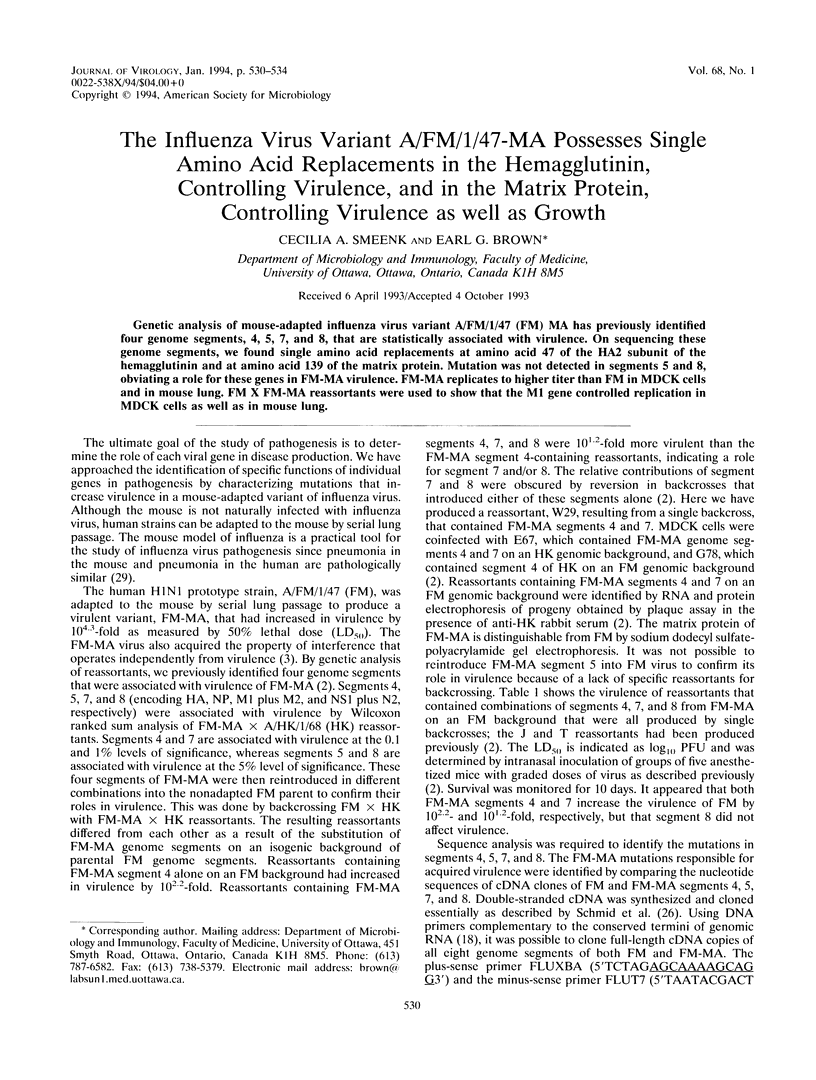
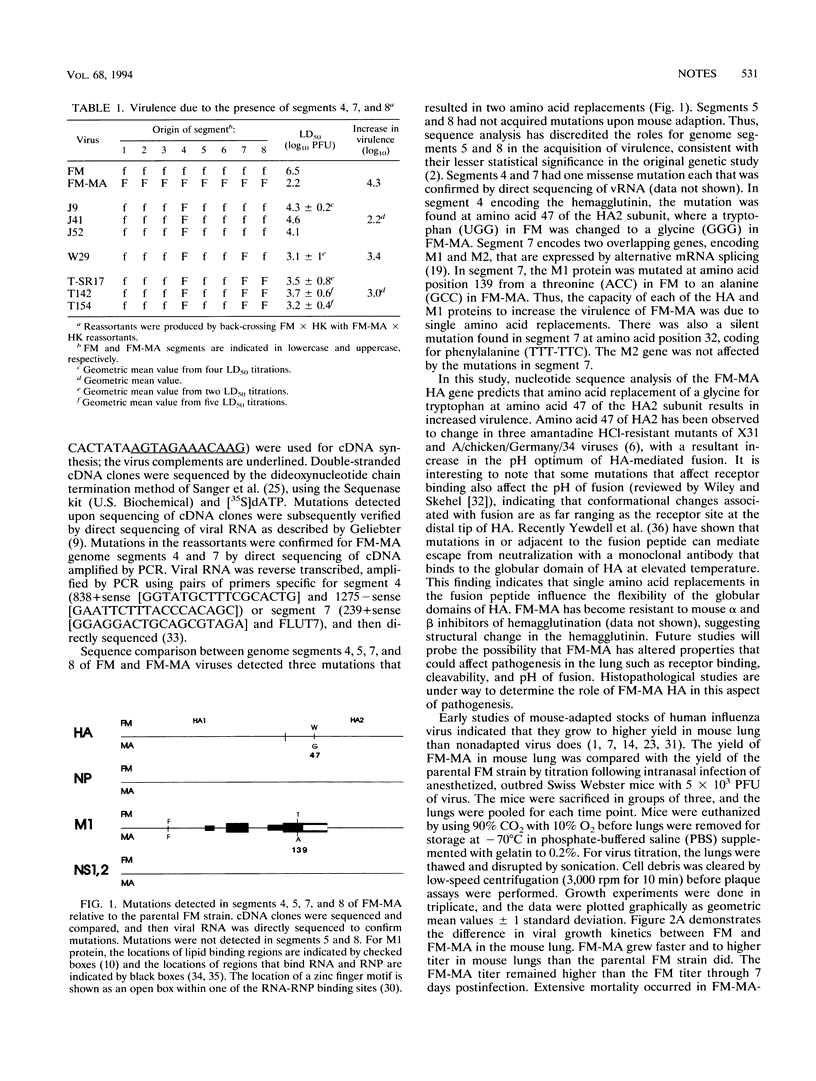
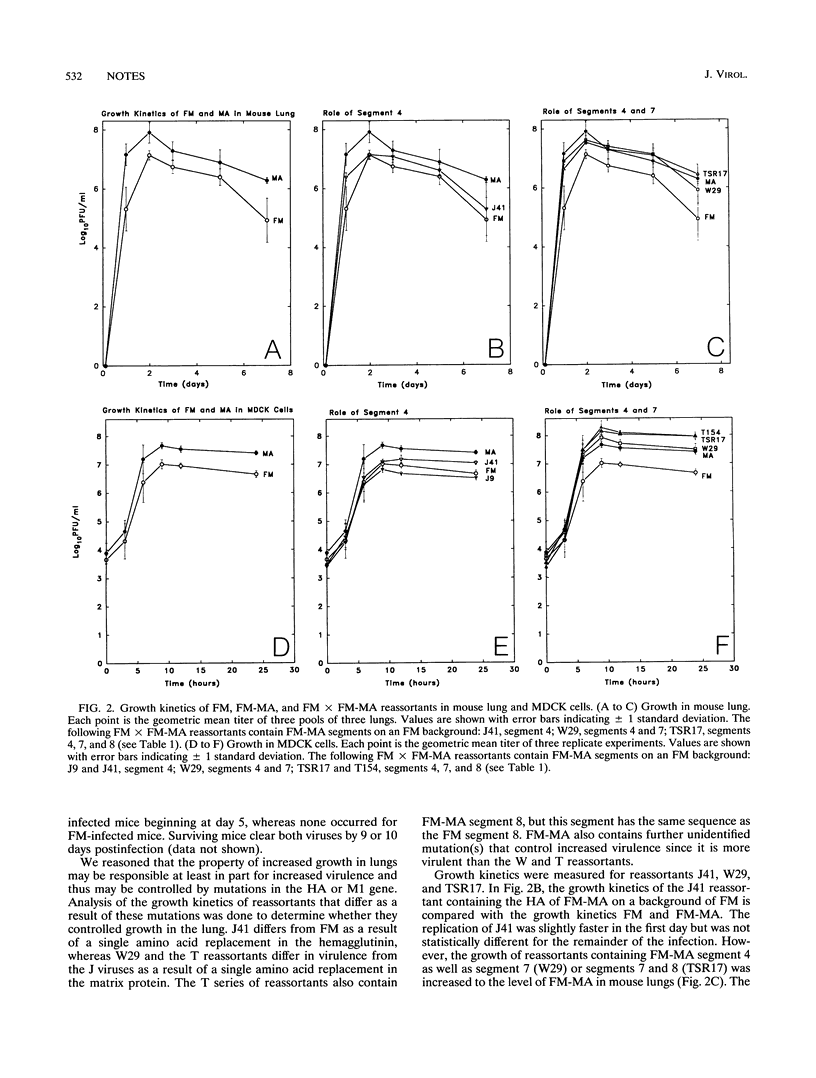
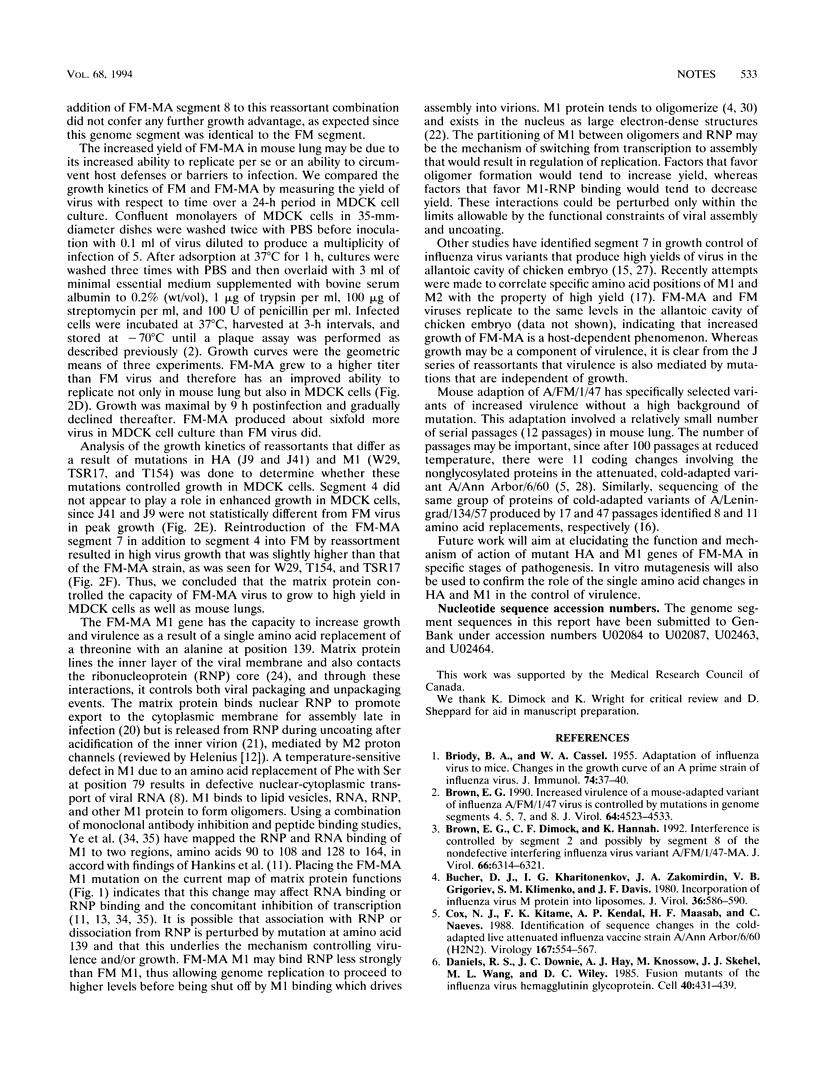
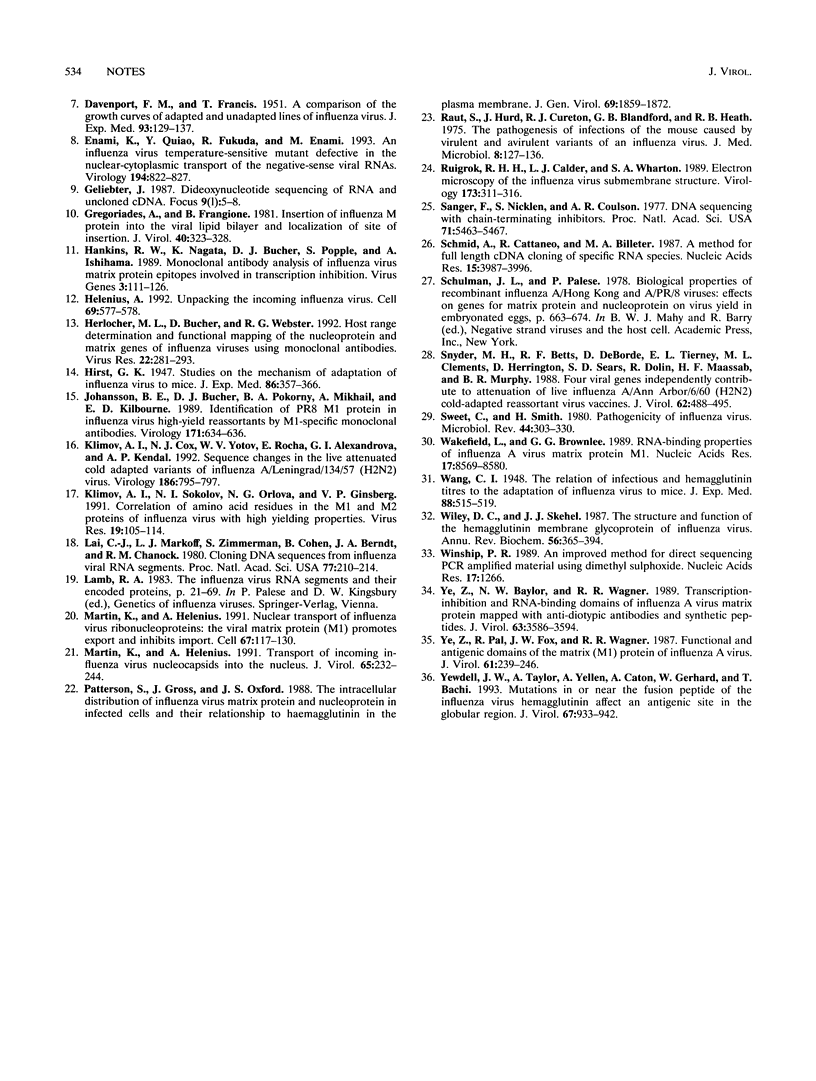
Selected References
These references are in PubMed. This may not be the complete list of references from this article.
- BRIODY B. A., CASSEL W. A. Adaptation of influenza virus to mice. II. Changes in the growth curve of an A prime strain of influenza virus. J Immunol. 1955 Jan;74(1):37–40. [PubMed] [Google Scholar]
- Brown E. G., Dimock C. F., Hannah K. Interference is controlled by segment 2 and possibly by segment 8 of the nondefective interfering influenza virus variant A/FM/1/47-MA. J Virol. 1992 Nov;66(11):6314–6321. doi: 10.1128/jvi.66.11.6314-6321.1992. [DOI] [PMC free article] [PubMed] [Google Scholar]
- Brown E. G. Increased virulence of a mouse-adapted variant of influenza A/FM/1/47 virus is controlled by mutations in genome segments 4, 5, 7, and 8. J Virol. 1990 Sep;64(9):4523–4533. doi: 10.1128/jvi.64.9.4523-4533.1990. [DOI] [PMC free article] [PubMed] [Google Scholar]
- Bucher D. J., Kharitonenkov I. G., Zakomirdin J. A., Grigoriev V. B., Klimenko S. M., Davis J. F. Incorporation of influenza virus M-protein into liposomes. J Virol. 1980 Nov;36(2):586–590. doi: 10.1128/jvi.36.2.586-590.1980. [DOI] [PMC free article] [PubMed] [Google Scholar]
- Cox N. J., Kitame F., Kendal A. P., Maassab H. F., Naeve C. Identification of sequence changes in the cold-adapted, live attenuated influenza vaccine strain, A/Ann Arbor/6/60 (H2N2). Virology. 1988 Dec;167(2):554–567. [PubMed] [Google Scholar]
- DAVENPORT F. M., FRANCIS T., Jr A comparison of the growth curves of adapted and unadapted lines of influenza virus. J Exp Med. 1951 Feb;93(2):129–137. doi: 10.1084/jem.93.2.129. [DOI] [PMC free article] [PubMed] [Google Scholar]
- Daniels R. S., Downie J. C., Hay A. J., Knossow M., Skehel J. J., Wang M. L., Wiley D. C. Fusion mutants of the influenza virus hemagglutinin glycoprotein. Cell. 1985 Feb;40(2):431–439. doi: 10.1016/0092-8674(85)90157-6. [DOI] [PubMed] [Google Scholar]
- Enami K., Qiao Y., Fukuda R., Enami M. An influenza virus temperature-sensitive mutant defective in the nuclear-cytoplasmic transport of the negative-sense viral RNAs. Virology. 1993 Jun;194(2):822–827. doi: 10.1006/viro.1993.1324. [DOI] [PubMed] [Google Scholar]
- Gregoriades A., Frangione B. Insertion of influenza M protein into the viral lipid bilayer and localization of site of insertion. J Virol. 1981 Oct;40(1):323–328. doi: 10.1128/jvi.40.1.323-328.1981. [DOI] [PMC free article] [PubMed] [Google Scholar]
- Hankins R. W., Nagata K., Bucher D. J., Popple S., Ishihama A. Monoclonal antibody analysis of influenza virus matrix protein epitopes involved in transcription inhibition. Virus Genes. 1989 Nov;3(2):111–126. doi: 10.1007/BF00125124. [DOI] [PubMed] [Google Scholar]
- Helenius A. Unpacking the incoming influenza virus. Cell. 1992 May 15;69(4):577–578. doi: 10.1016/0092-8674(92)90219-3. [DOI] [PubMed] [Google Scholar]
- Herlocher M. L., Bucher D., Webster R. G. Host range determination and functional mapping of the nucleoprotein and matrix genes of influenza viruses using monoclonal antibodies. Virus Res. 1992 Mar;22(3):281–293. doi: 10.1016/0168-1702(92)90058-h. [DOI] [PubMed] [Google Scholar]
- Johansson B. E., Bucher D. J., Pokorny B. A., Mikhail A., Kilbourne E. D. Identification of PR8 M1 protein in influenza virus high-yield reassortants by M1-specific monoclonal antibodies. Virology. 1989 Aug;171(2):634–636. doi: 10.1016/0042-6822(89)90638-7. [DOI] [PubMed] [Google Scholar]
- Klimov A. I., Cox N. J., Yotov W. V., Rocha E., Alexandrova G. I., Kendal A. P. Sequence changes in the live attenuated, cold-adapted variants of influenza A/Leningrad/134/57 (H2N2) virus. Virology. 1992 Feb;186(2):795–797. doi: 10.1016/0042-6822(92)90050-y. [DOI] [PubMed] [Google Scholar]
- Klimov A. I., Sokolov N. I., Orlova N. G., Ginzburg V. P. Correlation of amino acid residues in the M1 and M2 proteins of influenza virus with high yielding properties. Virus Res. 1991 Mar;19(1):105–114. doi: 10.1016/0168-1702(91)90098-g. [DOI] [PubMed] [Google Scholar]
- Lai C. J., Markoff L. J., Zimmerman S., Cohen B., Berndt J. A., Chanock R. M. Cloning DNA sequences from influenza viral RNA segments. Proc Natl Acad Sci U S A. 1980 Jan;77(1):210–214. doi: 10.1073/pnas.77.1.210. [DOI] [PMC free article] [PubMed] [Google Scholar]
- Martin K., Helenius A. Nuclear transport of influenza virus ribonucleoproteins: the viral matrix protein (M1) promotes export and inhibits import. Cell. 1991 Oct 4;67(1):117–130. doi: 10.1016/0092-8674(91)90576-k. [DOI] [PubMed] [Google Scholar]
- Martin K., Helenius A. Transport of incoming influenza virus nucleocapsids into the nucleus. J Virol. 1991 Jan;65(1):232–244. doi: 10.1128/jvi.65.1.232-244.1991. [DOI] [PMC free article] [PubMed] [Google Scholar]
- Patterson S., Gross J., Oxford J. S. The intracellular distribution of influenza virus matrix protein and nucleoprotein in infected cells and their relationship to haemagglutinin in the plasma membrane. J Gen Virol. 1988 Aug;69(Pt 8):1859–1872. doi: 10.1099/0022-1317-69-8-1859. [DOI] [PubMed] [Google Scholar]
- Raut S., Hurd J., Blandford G., Heath R. B., Cureton R. J. The pathogenesis of infections of the mouse caused by virulent and avirulent variants of an influenza virus. J Med Microbiol. 1975 Feb;8(1):127–136. doi: 10.1099/00222615-8-1-127. [DOI] [PubMed] [Google Scholar]
- Ruigrok R. W., Calder L. J., Wharton S. A. Electron microscopy of the influenza virus submembranal structure. Virology. 1989 Nov;173(1):311–316. doi: 10.1016/0042-6822(89)90248-1. [DOI] [PubMed] [Google Scholar]
- Sanger F., Nicklen S., Coulson A. R. DNA sequencing with chain-terminating inhibitors. Proc Natl Acad Sci U S A. 1977 Dec;74(12):5463–5467. doi: 10.1073/pnas.74.12.5463. [DOI] [PMC free article] [PubMed] [Google Scholar]
- Schmid A., Cattaneo R., Billeter M. A. A procedure for selective full length cDNA cloning of specific RNA species. Nucleic Acids Res. 1987 May 26;15(10):3987–3996. doi: 10.1093/nar/15.10.3987. [DOI] [PMC free article] [PubMed] [Google Scholar]
- Snyder M. H., Betts R. F., DeBorde D., Tierney E. L., Clements M. L., Herrington D., Sears S. D., Dolin R., Maassab H. F., Murphy B. R. Four viral genes independently contribute to attenuation of live influenza A/Ann Arbor/6/60 (H2N2) cold-adapted reassortant virus vaccines. J Virol. 1988 Feb;62(2):488–495. doi: 10.1128/jvi.62.2.488-495.1988. [DOI] [PMC free article] [PubMed] [Google Scholar]
- Sweet C., Smith H. Pathogenicity of influenza virus. Microbiol Rev. 1980 Jun;44(2):303–330. doi: 10.1128/mr.44.2.303-330.1980. [DOI] [PMC free article] [PubMed] [Google Scholar]
- Wakefield L., Brownlee G. G. RNA-binding properties of influenza A virus matrix protein M1. Nucleic Acids Res. 1989 Nov 11;17(21):8569–8580. doi: 10.1093/nar/17.21.8569. [DOI] [PMC free article] [PubMed] [Google Scholar]
- Wiley D. C., Skehel J. J. The structure and function of the hemagglutinin membrane glycoprotein of influenza virus. Annu Rev Biochem. 1987;56:365–394. doi: 10.1146/annurev.bi.56.070187.002053. [DOI] [PubMed] [Google Scholar]
- Winship P. R. An improved method for directly sequencing PCR amplified material using dimethyl sulphoxide. Nucleic Acids Res. 1989 Feb 11;17(3):1266–1266. doi: 10.1093/nar/17.3.1266. [DOI] [PMC free article] [PubMed] [Google Scholar]
- Ye Z. P., Baylor N. W., Wagner R. R. Transcription-inhibition and RNA-binding domains of influenza A virus matrix protein mapped with anti-idiotypic antibodies and synthetic peptides. J Virol. 1989 Sep;63(9):3586–3594. doi: 10.1128/jvi.63.9.3586-3594.1989. [DOI] [PMC free article] [PubMed] [Google Scholar]
- Ye Z. P., Pal R., Fox J. W., Wagner R. R. Functional and antigenic domains of the matrix (M1) protein of influenza A virus. J Virol. 1987 Feb;61(2):239–246. doi: 10.1128/jvi.61.2.239-246.1987. [DOI] [PMC free article] [PubMed] [Google Scholar]
- Yewdell J. W., Taylor A., Yellen A., Caton A., Gerhard W., Bächi T. Mutations in or near the fusion peptide of the influenza virus hemagglutinin affect an antigenic site in the globular region. J Virol. 1993 Feb;67(2):933–942. doi: 10.1128/jvi.67.2.933-942.1993. [DOI] [PMC free article] [PubMed] [Google Scholar]


